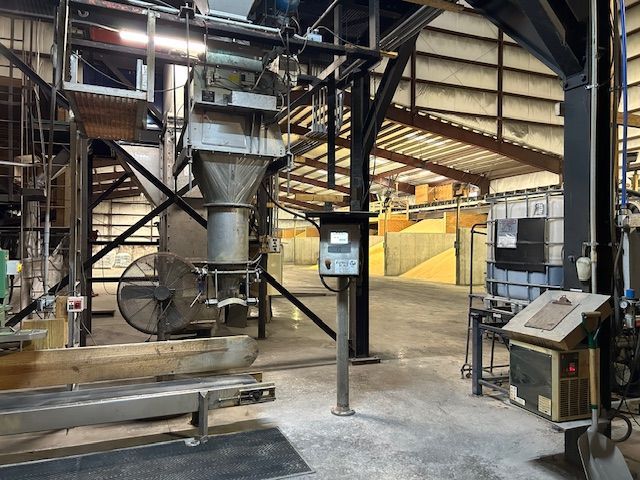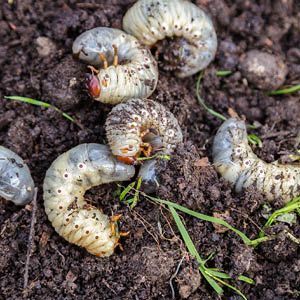DISCOVER HOW TO APPLY SEED TO LAWNS IN SPRING
When spring arrives and the turf appears to be patchy or you need to establish a whole new lawn, although best recommended in fall, spring can also provide a good environment for grass seed germination. Even well maintained lawns can become patchy and thin over time for multiple reasons; some factors that can lead to damage include, insects, grass disease, environmental stresses and weather. Spring weather offers frequent rain showers and ideal temperatures that warm the soil to assist with seed germination, allowing new turf to mature before the summer heat hits. There are three different techniques to manage thin or spotty turf, they include: spot seeding, overseeding/ reseeding, or total lawn renovation or installation.
- Spot Seeding is the technique that is the quickest and easiest form or repairing spotty lawns because it involves spreading seed to small areas of dead grass (i.e. worn areas from foot traffic or roots from vehicles or heavy objects in the lawn).
- Overseeding/Reseeding refers to the technique of spreading new grass seed on top of an already established lawn in order to return a thin or damaged lawn to a healthy looking one.
- Lawn Renovation or Installation refers to extreme cases where lawns are experiencing excessive thatch and/or are so thin that they need to be completely replanted or to install/establish a new lawn like in the case of new construction. Renovating a lawn can involve a lot of time and hard work because you need to remove the old lawn (which might include sod cutters or dethatching) before you are able to prepare the soil and reseed. For new lawn installation, the process is simple, since there is no previous lawn to remove you can just prepare the soil and reseed.
BEST TIME TO PLANT
Although its recommended to seed in fall, its sometimes unavoidable and a lawn will need to be filled in or planted come spring (the second-best time to of the year for planting grass seed). It’s important to understand that the times between March-May are best times to plant grass seed because soil temperature range between 50-60°F, the ideal temperature for grass seed germination.
- TIP: When daytime air temperatures are between 60-75°F consistently, then it’s a good indication that soil is at a suitable temperature for new grass.
HOW TO PICK THE RIGHT GRASS SEED
When planting new grass seed it’s important to determine which grasses grow best in your area. Grass types such as Kentucky bluegrass, fescue or perennial ryegrass are most commonly found in northern regions while grass types such as Bermuda, centipede, St. Augustine and zoysia are commonly found in southern regions. Your local lawn care expert will be able to help identify whether cool season grasses or warm season grasses are more common in the area and then can direct you to the proper grass seeded need.
PREPARING SOIL FOR SEED
In order to cultivate a healthy lawn with rapid germination and growth, the proper soil preparations need to be prepared.
STEPS TO PREPARING A BARE SOIL BED
TECHNIQUES FOR LAWN RENOVATION OR INSTALLATION
TECHNIQUES FOR LAWN RENOVATION OR INSTALLATION
This process should take place a few weeks prior to new seeding.
- Check soil pH to be certain that soil is ready for seed. Seed germinates best in a balance/neutral soil pH. NOTE: Check the recommended pH level on grass species you are planting, some pH levels vary. See step 6 on how to balance pH level.
- Till the top 2-3 inches of the soil with a tiller (for cases on a smaller scale, a garden rake can work great too).
- Clear debris that has been tilled up, including weeds, rocks and branches.
- Rake soil in order to level out as well as breaking up or removing any clumps of soil that are too large.
- Allow the soil to settle to prevent dropping later, lightly firm soil down after tilling by treading on it with our feet or using a light roller. NOTE: Allow this to settle for a week or two.
- After soil has settle, gently rake soil to loosen the top layer again in order to allow an application of a soil amendment like lime (to increase pH level in acid soil) or sulfur (to reduce pH level in alkaline soil). Review product label instructions for proper application rates. Understand that this should be applied with a spreader and not by hand. TIP: Even if your soil has a balanced pH, an application of a soil amendment will help unlock key nutrients locked up in soil to enhance seed germination.
- Apply a starter fertilizer to give the new grass seed the nutrients needed to grow. Follow instructions on the back of the product label for proper application rates.
- The night before seeding, water the soil so its damp, not saturated.
- Apply grass seed with spreader! Review grass seed label instructions for proper applications.
STEPS TO PREPARING A SEED BED IN AN ESTABLISHED LAWN
TECHNIQUES FOR SPOT SEEDING OR OVERSEEDING
TECHNIQUES FOR SPOT SEEDING OR OVERSEEDING
This process should take place a few weeks prior to new seeding.
- Check soil pH to be certain that soil is ready for seed. NOTE: During this step, if soil is too acidic or alkaline it’s okay, follow step 5 below prior to addressing soil pH with an application of lime or gypsum.
- Aerate the lawn in order to break up compact soil. NOTE: Don’t worry about the soil plugs because they will naturally decompose and be broken up by the mower. If plugs are still excessive, gently break them apart with a rake.
- Mow the lawn to its lowest mowing height.
- Rake to clear debris including rocks, branches and grass clippings. TIP: Grass clippings are great for putting nutrients back into your lawn, instead of throwing them away to be taken to a landfill, try using them in gardens or around trees for natural fertilization.
- Apply a soil amendment like lime (acid soil) or sulfur (alkaline soil). Review product label instructions for proper application rates. Understand that this should be applied with a spreader and not by hand. TIP: Even if your soil has a balanced pH, an application of an enhanced soil amendment like AMP-XC™ will help unlock key nutrients locked up in soil and greatly increase the speed of seed germination, leading to a fuller lawn more quickly.
- Apply a fertilizer to give the new grass seed the nutrients needed to grow. Follow instructions on the back of the product label for proper application rates. NOTE: DO NOT APPLY a weed & feed with fertilizer to a lawn that is going to be reseeded. This will prevent new grass seed germination. Post-pone a weed & feed application until turf has been mowed 4-5 times, giving time for a root system to grow
- The night before seeding, water the soil so its damp, not saturated.
- Apply grass seed with spreader! Review grass seed label instructions for proper applications.
With the proper soil preparations, including applications of soil amendments, fertilization and watering, your grass seed should be on its way to growing into a beautiful lush lawn. Take the proper steps will ensure your seed become strong, healthy turf that will be able to survive against environmental stresses, weeds, pests and disease. A good rule of thumb is to make sure the new grass has plenty of water (not saturated). Please note, a freshly seeded lawn should have limited activity so be sure to refrain from walking on or mowing it. Once it reaches 3 inches it’s okay to mow again; this includes having patience after over seeded or patch/spot seeded lawns because the established lawn will continue to grow. Allow 2-4 weeks until mowing can resume when using these techniques. Follow up with proper lawn care treatments
and fertilization and you should have a healthy looking lawn that will last for season to come.
For professional fertilizers, humic and AMP-XC™ enriched products available, please visit TurfCare’s online Product Catalog.
For green industry professionals or others interested in ordering Turfcare products, please contact our Customer Service to find a distributor near you.
References
http://homeguides.sfgate.com/plant-grass-seed-spring-39233.html
https://www.trugreen.com/blog/overseeding/the-basics-of-overseeding-a-lawn
https://www.trugreen.com/blog/overseeding/overseeding-in-spring-can-i-just-throw-the-seed-on-my-lawn
https://www.spring-green.com/lawn-care-guide/lawn-seeding-tips/
http://fescue.com/info/whentoplant.html#.WLBCtbGZNLw
https://www.thisoldhouse.com/how-to/how-to-seed-lawn
https://www.trugreen.com/blog/overseeding/own-the-yard-how-to-care-for-your-lawn-after-overseeding
https://theseamanmom.com/how-to-prepare-soil-for-grass-seed/
Turf Care Supply - TurfReport Blog

Turf Care Supply, LLC, a portfolio company of Platte River Equity, has officially acquired Beaty Fertilizer, the industry respected Tennessee-based manufacturer and blender of custom granular and liquid fertilizers, as well as combination products. This strategic move expands Turf Care’s manufacturing footprint, adds new product capabilities, and enhances overall production capacity. “The partnership with Beaty Fertilizer marks a major milestone in our journey and an important step forward in our mission to grow, innovate and lead in our industry,” said Mark Mangan, President of Turf Care. “This acquisition is more than just expansion; it’s a powerful opportunity to strengthen our product offerings, broaden our market reach and provide greater value to our customers. By welcoming Beaty into the Turf Care family, we are reinforcing our commitment to excellence and positioning ourselves for an even brighter future.” “We are excited about this next step in the Beaty Fertilizer story. For almost 50 years, our family and our employees have worked hard to serve customers and communities with pride and heart,” said John Beaty, President of Beaty. “Now, we are embracing an opportunity for growth with Turf Care. With our combined know-how and resources, we’ll keep building on what we’ve worked so hard to create and bring even more value to our customers, employees and partners. We truly believe this partnership will keep the Beaty legacy going strong while opening up new doors for growth and innovation.” Tarun Kanthety, Vice President at Platte River, added, “We believe the acquisition of Beaty Fertilizer represents a strategic step in expanding Turf Care’s footprint and product breadth... as it scales and enhances its value proposition to customers.”

Root out Grubs, Before they Attack Yours! White grubs, the immature stage of several scarab beetles—including Japanese beetles, masked chafers, May and June beetles, and green June beetles—are a major threat to turfgrass across the Southeast. These beetles follow a complete metamorphosis (egg, grub, pupa, adult), with most species completing their cycle in one year. Eggs are laid in early summer, grubs hatch within two weeks, and begin feeding on turfgrass roots through the late summer and fall. May and June beetles differ slightly, with a two- to three-year life cycle and prolonged feeding as third-instar grubs. Grubs damage turf by severing roots, causing grass to yellow, wilt, or lift easily from the soil. Feeding is typically concentrated in patches and worsens during hot, dry weather. Wildlife digging for grubs can create further turf destruction. Healthy turf may tolerate 5–10 grubs per square foot, but damage becomes evident as populations rise or turf is under stress. Early detection and timing are essential. Scouting begins in late June, shortly after adult beetle activity peaks. Monitoring plants favored by beetles can signal egg-laying is underway. Treatment is most effective when small grubs are active—typically from mid-July through early August. For professional turfgrass managers, insecticides containing imidacloprid (Merit®), chlorantraniliprole (Acelepryn®), or trichlorfon (Dylox®) are the most effective tools. The primary months of preventative application of Acelepryn® is from April to end of May and Merit® from April into July - targeting grubs before they hatch. Curative treatments with Dylox® or similar products are applied July through the fall, when young grubs are feeding and most vulnerable. Always follow label directions for optimal application and safety. Timing may vary slightly by regional seasonal needs. Turf Care Supply has a variety of professional TCS Growstar insecticide fertilizers available to protect your turf and prevent grub damage, before it starts. Click on the button below to view products, contact your sales rep for addition TC Growstar products available.

Platte River Equity Portfolio Company Turf Care Supply, LLC Acquires Agri-Nutrients, Inc. Brunswick, OH , October 9, 2024 – Platte River Equity (“Platte River”) portfolio company Turf Care Supply, LLC (“Turf Care”) is pleased to announce its acquisition of Agri-Nutrients, Inc. (“Agri-Nutrients”), a manufacturer and blender of custom granular fertilizers for the turf & ornamental (“T&O”) industry. This strategic acquisition provides Turf Care with an established presence in the south-central United States, an enhanced product portfolio and additional manufacturing capacity. “This acquisition represents much more than a business transaction; it is a strategic step forward in expanding our reach and enhancing our customers’ growth. By bringing Agri-Nutrients into the Turf Care family, we are broadening our product portfolio, expanding our market presence and further positioning ourselves as a leader in providing innovative solutions for our customers,” said Mark Mangan, President of Turf Care. “We are excited about joining the Turf Care team,” said Jim Montgomery, President of Agri-Nutrients. “At Agri-Nutrients, our core values center around customer service and product innovation, and we are confident that this combination will allow us to better serve the needs of our customers.” “Platte River welcomes the Agri-Nutrients team to Turf Care. This transaction underscores our long-term commitment to fostering growth through both organic and inorganic initiatives across the Turf Care platform,” said Tarun Kanthety, Vice President of Platte River. “The partnership with Agri-Nutrients strengthens Turf Care’s value-added offering, creating additional growth opportunities across the combined customer base.” B&A Corporate Advisors served as the exclusive financial advisor to Agri-Nutrients. About Agri-Nutrients Founded in 1992 and based in Catoosa, OK, Agri-Nutrients is a manufacturer and blender of custom granular fertilizers for the T&O industry, predominantly selling into the lawn care, sports turf and golf course end markets. About Turf Care Supply Established in 1974, Turf Care Supply is one of the largest formulators and blenders of urea products to the T&O market. Turf Care has a comprehensive product portfolio of fertilizers, combination products (herbicide/insecticide), soil amendments and enhanced efficiency fertilizer ingredients. Turf Care's products are sold to distributors and blenders serving the commercial, residential and golf end markets. Turf Care operates four manufacturing facilities strategically located throughout the eastern U.S. About Platte River Equity Founded in 2006 and based in Denver, CO, Platte River Equity is a private equity firm focused on investments in established lower middle market operating companies within targeted industrial sectors where it has substantial operating and investing experience. Platte River utilizes prudent capital structures in order to invest in future growth opportunities and withstand changing economic environments. The firm also provides significant ongoing support to its portfolio companies through dedicated resources across functional areas. The firm has raised funds with committed capital in excess of $1.6 billion and is currently investing out of its fifth fund. The Platte River team is the largest collective investor across its funds, deeply aligning the firm with its investors and portfolio company management teams.

